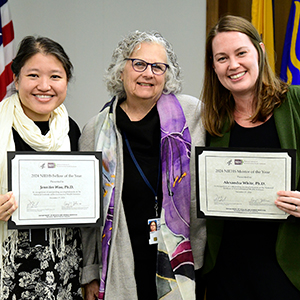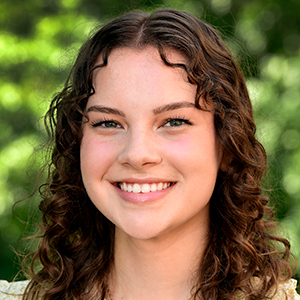Lars Pedersen, Ph.D., head of the NIEHS Structure Function Group, helps institute scientists bolster their research through X-ray crystallography. That technique allows for the determination of macromolecules in three dimensions, which increases understanding of biological processes involved in disease and exposure to toxic substances, for example.
 “There are so many interesting biological systems to study, and I can easily become engaged in a variety of projects because the underlying chemistry is what grabs me,” said Pedersen. (Photo courtesy of Steve McCaw)
“There are so many interesting biological systems to study, and I can easily become engaged in a variety of projects because the underlying chemistry is what grabs me,” said Pedersen. (Photo courtesy of Steve McCaw)As an independent investigator, he studies the biosynthesis of heparan sulfates, which are chains of carbohydrate molecules. Pedersen currently is assessing whether those chains could block the coronavirus spike protein from binding to cells, potentially reducing chances of infection. Environmental Factor sat down with him to learn about his research and background.
EF: What is the most important aspect of your work at the institute?
Pedersen: I have found that in science, every project you work on is the world’s most important project! But seriously, my team is here for anyone at the institute interested in understanding how a macromolecule functions — its chemical bonds, the ways mutations or environmental exposures affect it, and so forth. Our group helps researchers visualize those processes.
We provide support in many areas, including protein purification, crystallization, solving structures, and even writing manuscripts. Our group also works with scientists who may not know how to interpret a particular structure or use related software. Sometimes, we train postdoctoral fellows who want to learn all of these things. So, we wear many different hats.
EF: Can you describe some of your collaborations?
Pedersen: One of our longest-standing projects involves the lab of Tom Kunkel, Ph.D., who studies DNA damage and repair. We look at ways X family polymerases help repair DNA but also certain errors that they may cause. My colleague Andrea Kaminski plays a critical role in that work and deserves much of the credit.
Another partnership is with Geoff Mueller, Ph.D., head of the Nuclear Magnetic Resonance Group, to better understand allergies. Our team determined the structures of several allergens to start thinking about how to desensitize people who may have strong reactions to things such as peanuts. I am proud that we solved structures of major allergens from peanuts and cockroaches.
For my own research, I sometimes work with scientists from UNC [the University of North Carolina at Chapel Hill] on projects related to heparan sulfate. Heparin [a highly sulfated form of heparan sulfate] is purified from pigs as an anticoagulant, but it also has anti-inflammatory, anti-metastatic, and antiviral properties.
Our goal is to synthesize drug compounds from heparan sulfate so that if patients receive an antiviral, for example, they do not experience anticoagulation side effects. We also are studying whether heparan sulfate can block the SARS-CoV-2 spike protein from binding to cells. It is a long shot, but the aim is to see whether we can accomplish that without causing unwanted side effects.
EF: What did you do before joining NIEHS?
Pedersen: During my undergraduate years at UNC, I played on the school’s lacrosse team. I was a benchwarmer, but it was exciting to dress up for the game and occasionally get playing time. I grew up in Chapel Hill, so wearing that jersey was pretty special.
After college, I earned my Ph.D. in biochemistry from the University of Washington. Then I completed my first postdoctoral training at the University of Wisconsin, where I worked on projects related to antibiotic resistance.
In 1996, my interest in structural biology and drug development led me to a second postdoctoral stint, this time with Masahiko Negishi, Ph.D., who heads the NIEHS Pharmacogenetics Group. An opportunity arose for me to remain at the institute after my training, and the decision was a no-brainer. The collegiality and fruitful exchanges here are truly special.
Citations:
Kaminski AM, Chiruvella KK, Ramsden DA, Kunkel TA, Bebenek K, Pedersen LC. 2019. Unexpected behavior of DNA polymerase Mu opposite template 8-oxo-7,8-dihydro-2'-guanosine. Nucleic Acids Res 47(17):9410-9422.
Mueller GA, Min J, Foo ACY, Pomes A, Pedersen LC. 2019. Structural analysis of recent allergen-antibody complexes and future directions. Curr Allergy Asthma Rep 19(3):17. doi: 10.1007/s11882-019-0848-4.
(Jesse Saffron, J.D., is a technical writer-editor in the NIEHS Office of Communications and Public Liaison.)









